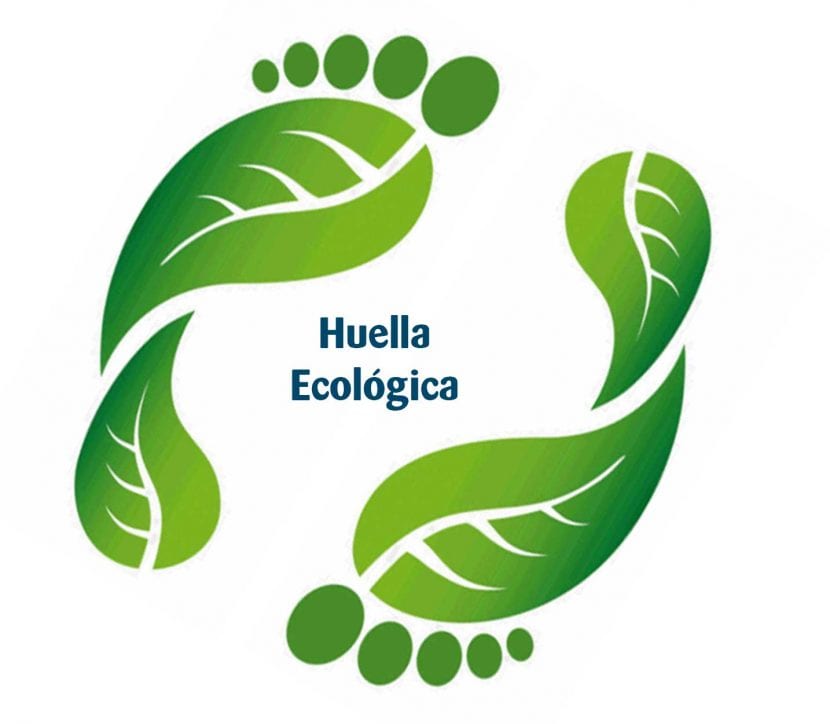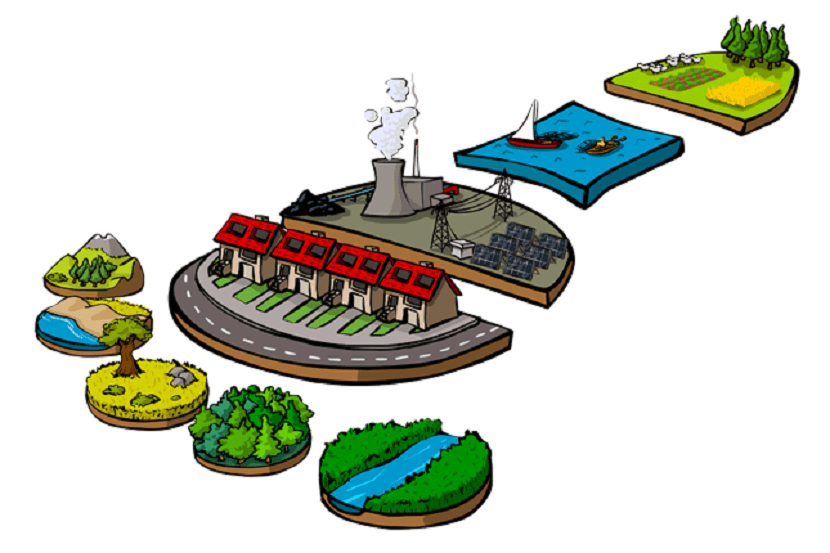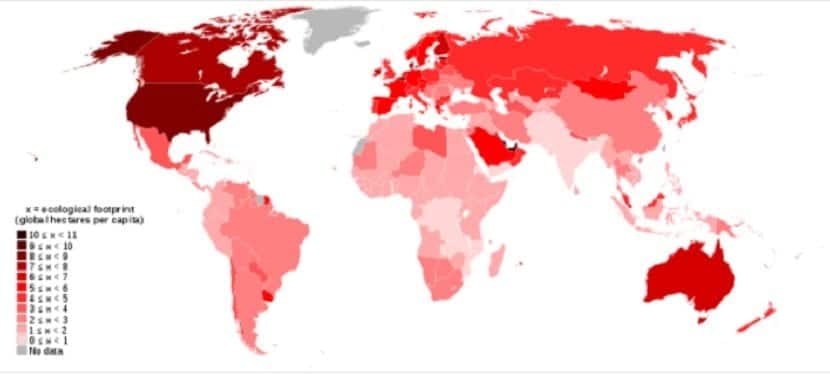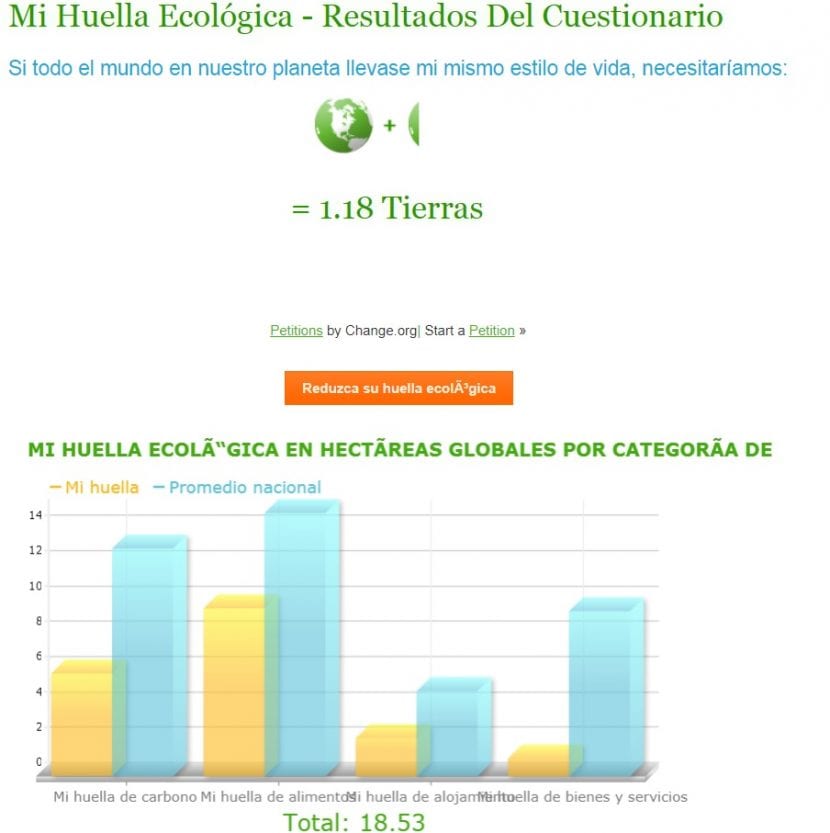
There has been a international sustainability indicator and you've surely heard of it. This indicator is the ecological footprint.
With the new challenges that arise, we need to increase and complete all the possible information that GDP (Gross Domestic Product) can offer us, an iIndicator used worldwide in the economic context.This is necessary to be able to design balanced policies that can reflect the commitment to the Environment and to social well-being.
This biophysical indicator of sustainability, and I am already talking only about the ecological footprint, is capable of integrating the set of impacts that a human community has on its environment. Considering as is logical, all the necessary resources as well as the waste generated in said community.
What is the ecological footprint?
The ecological footprint is therefore defined as
the total ecologically productive area necessary to produce the resources consumed by an average citizen of a given human community, as well as that necessary to absorb the waste it generates, regardless of the location of these areas
The study of the ecological footprint
In order to establish it as an indicator, we first have to know how to calculate said footprint, for this, aspects such as:
A flow of materials and energy is always needed to produce any good or service (regardless of the technology used). These materials and energy from ecological systems or direct energy flow from the Sun in its different manifestations.
They are also needed, ecological systems to absorb the waste generated during the production process and the use of the final products.
The surfaces of the productive ecosystems are reduced since the space is occupied with houses, equipment, infrastructures ...
In this way we can see how this indicator integrates multiple impacts, although others must also be taken into account, such as those that underestimate the real environmental impact.

Real environmental impact
Some impacts are not accounted for, especially of a qualitative nature, such as contamination of the soil, water, and the atmosphere (except for CO2), erosion, loss of biodiversity or degradation from the landscape.
It is assumed that the practices in the agricultural, livestock and forestry sectors are sustainable, that is, that the productivity of the soil does not decrease over time.
The impact associated with the use of water is not taken into account, with the exception of the direct occupation of the land by reservoirs and hydraulic infrastructures and the energy associated with the management of the water cycle.
As a general criterion, it is tried not to count those aspects for which there are doubts about the quality of the calculation.
In this regard, there is also always a tendency to choose the most prudent option when it comes to obtaining results.
Biocapacity
A complementary element to the ecological footprint is the biocapacity of a territory. It is nothing more than the biologically productive area that is available such as crops, forests, pastures, the productive sea ...
I refer to biocapacity as a complementary element because the difference of these indicators gives us as a result the ecological deficit. That is, the ecological deficit is equal to the resource demand (ecological footprint) less available resources (biocapacity).
From a global point of view, it has been estimated at 1,8 ha the planet's biocapacity for each inhabitant, or what is the same, if we had to distribute the productive land of the earth in equal parts, to each of the more than six billion inhabitants on the planet, 1,8 hectares would correspond to satisfy all their needs during one year.
This gives us an idea of the great consumption and expenditure we make, and that is, if we continue like this, the Earth will not be able to supply everyone.
As curious data to comment that USA has a footprint of 9.6This means that if the whole world lives like the US it would take more than 9 and a half planets Earth.
The ecological footprint of Spain is 5.4
Calculate the ecological footprint
The calculation of this indicator is based on the estimation of the productive area necessary to satisfy the consumption associated with food, to forest products, energy consumption and direct land occupation.
To know these surfaces, two steps are carried out:
Count the consumption of the different categories in physical units
In the event that there are no direct consumption data, the apparent consumption for each product is estimated with the following expression:
Apparent consumption = Production - Export + Import
Transform these consumptions into an appropriate productive biological surface through productivity indexes
This is equivalent to calculating the area necessary to satisfy the average per capita consumption of a given product. Productivity values are used.
Ecological footprint = Consumption / Productivity
The productivity values that we will use can be referred to a global scale, or they can be calculated specifically for a certain territory, thus considering the applied technology and the performance of the land.
For the standard calculation, the use of global productivity factors (as is the case you have seen above) because it is possible in this way to make a comparison of the values obtained from the ecological footprint at a local scale and contributes to the total normalization of the indicator.
Energy consumption
To obtain the ecological footprint in regard to energy consumption, it is done differently depending on the energy source to be considered.
For fossil fuels. Main source of energy consumed, although decreasing thanks to renewable energies, the ecological footprint measures the area of absorption of CO2.
This is obtained from the total energy consumption, both direct and associated with the production and distribution of the goods and services consumed, divided by the CO2 fixation capacity of the forest area.

Remaining calculation
Once the consumptions have been counted and the productivity indices applied, we can have the different productive areas considered (crops, pastures, forests, sea or artificial surfaces).
Each category has different biological productivities (for example: one hectare of crops is more productive than one of the sea), and before adding them it is necessary to proceed to what is defined as normalization.
To do this, each surface it is weighted by means of equivalence factors that express the relationship between the biological productivity of each category of surface with respect to the average productivity of the planet's surface.
In this sense, the fact that the equivalence factor of the forests is 1,37 means that the productivity of one hectare of forest has, on average, 37% more productivity than the average productivity of the entire area. of global productive space.
Once the equivalence factors have been applied to each category of calculated surface, we now have the ecological footprint expressed in what is known as global hectares (gha).
And with all this if we can proceed to add all of them and thus obtain the total ecological footprint.
Calculate your own ecological footprint
Have you ever wondered how much "nature" your lifestyle requires? The questionnaire "The ecological footprint" calculates the amount of land and ocean area necessary to maintain your consumption patterns and absorb your waste annually.
As a common pattern, these tools usually address the following areas:
- Energy: Use of energy in the home. Global calculations by type of energy per year, as well as the cost involved.
- Water: Estimation of percentages of consumption on the average and of the consequences of generalizing your style of spending water.
- Shipping cost: How many complete turns could you make the planet by adding all the displacements in a year.
- Waste and materials: Amount of garbage generated in the home per person and percentages of recyclable materials.
After replying to 27 simple questions In MyFootPrint, you will be able to compare your ecological footprint with that of other people and discover how we can reduce our impact on the Earth.
Visit the page myfootprint and answer the questions.
If everyone lived and had the same lifestyle we would need 1,18 Earths, I pass by very little although in recent years it has decreased since when I first learned about the concept of ecological footprint I did it and I remember that I was 1,40, so we are on the right track.
Neutralize our ecological footprint

Global ecological footprint
For the composition of the ecological footprint in Spain the most important factor is the energy footprint, having a share of 68%, well above the 50% established worldwide.
For this reason, it is important to note that the main component of this footprint (the energy footprint) is the production of consumer goods with 47,5%, this It is calculated with direct energy consumption and with the energy contained in imported goods.
After in second place we have the transport and mobility sector with 23,4% and in third place housing with 11,2%.
Based on these data, it is estimated that Spain has an ecological deficit of 4 ha per person, that is, 175 million hectares nationwide.
In short, annually the Spanish population needs more than 2,5 times its territory to be able to sustain the standard of living and population. Therefore, we have an ecological deficit that is above the EU average and that shows that Spain has space only to provide food and forest products to the current population.
But the important thing here is that once we have the result of the ecological footprint we must reduce it.
Reducing the global footprint or at the personal level is nothing more than applying good sustainable habits such as the rational use of water, the use of public transport or another means that does not pollute, recycling, the use of low consumption light bulbs, the insulation of windows and doors, the use of efficient appliances and a long etc.
These simple customs (which cost a little at first but eventually become part of our lives) can have an impact on domestic energy savings approximately 9% per household.
